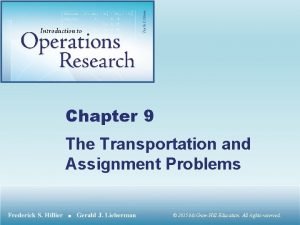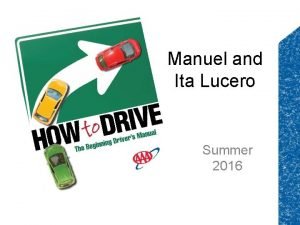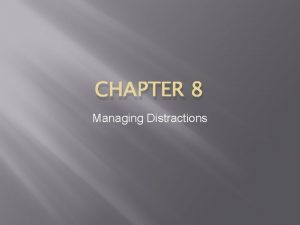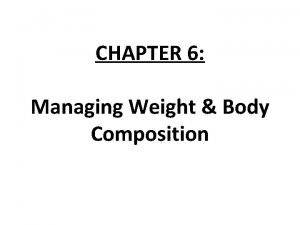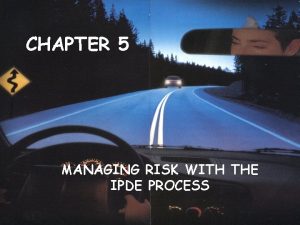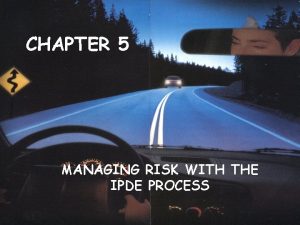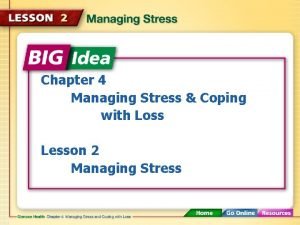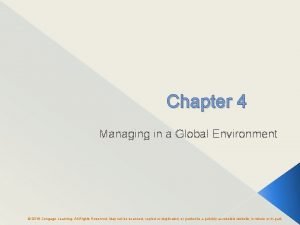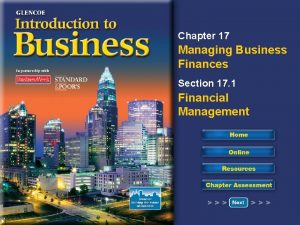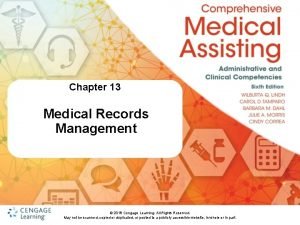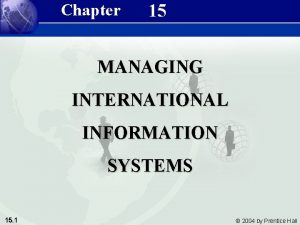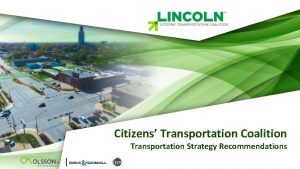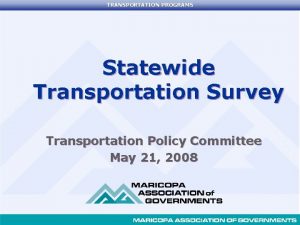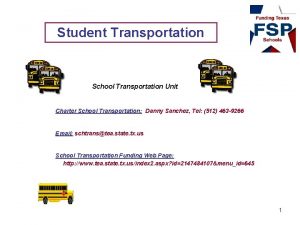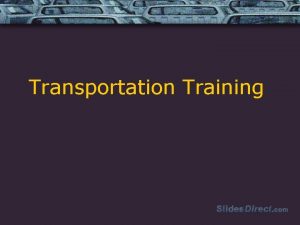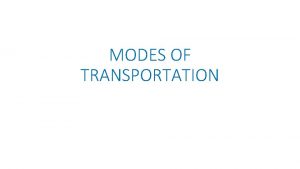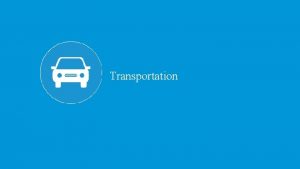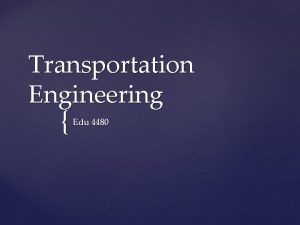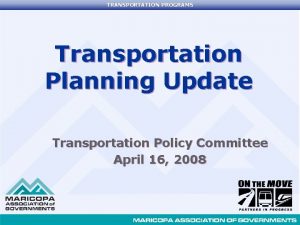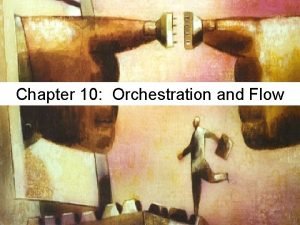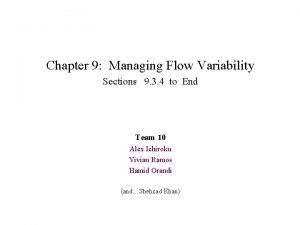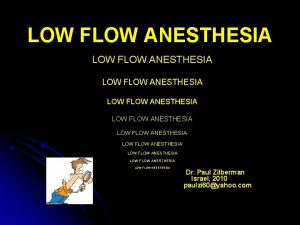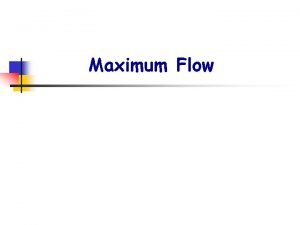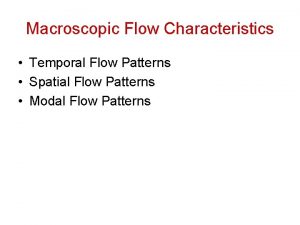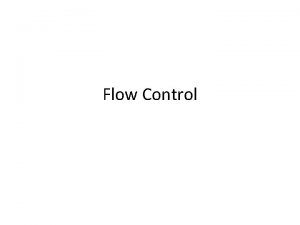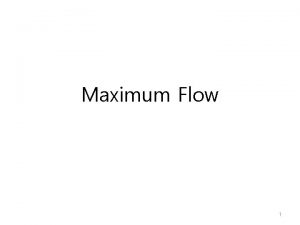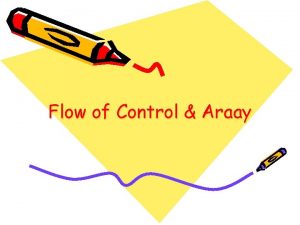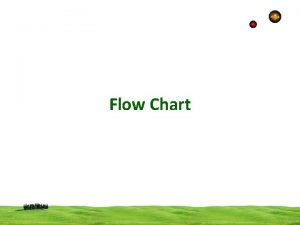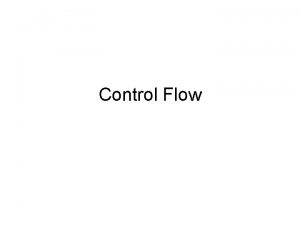CHAPTER 11 Transportation Managing the Flow of the










































- Slides: 42

CHAPTER 11 Transportation— Managing the Flow of the Supply Chain Management: A Logistics Perspective (10 e) Coyle, Langley, Novack, and Gibson © 2016 Cengage Learning. All Rights Reserved. May not be scanned, copied or duplicated, or posted to a publicly accessible website, in whole or in part.

Discussion Outline Ù The role of transportation in supply chain management Ù Modes of transportation Ù Transportation planning and strategy Ù Transportation execution and control Ù Transportation technology © 2016 Cengage Learning. All Rights Reserved. May not be scanned, copied or duplicated, or posted to a publicly accessible website, in whole or in part. 2

The Role of Transportation in Supply Chain Management (SCM) Transportation provides the critical links between organizations in a supply chain network, permitting goods to flow between their facilities. Transportation also influences supply chain design, strategy development, and total cost management. Transport service availability Transport efficiency Demand fulfillment Supply chain competitiveness Customerfocused transport Effective transport Organization success Supply chain flexibility © 2016 Cengage Learning. All Rights Reserved. May not be scanned, copied or duplicated, or posted to a publicly accessible website, in whole or in part. 3

The Role of Transportation in SCM Role Inhibitors Offshore manufacturing Growing governmental requirements Transportation rate variation Changing customer requirements Transportation capacity constraints © 2016 Cengage Learning. All Rights Reserved. May not be scanned, copied or duplicated, or posted to a publicly accessible website, in whole or in part. 4

Modes of Transportation

Modes of Transportation The five basic modes of transportation and intermodal transportation each has different economic and technical structures, and each can provide different qualities of link service. Freight Shipments within the US (2015) Mode of Transportation Value of Goods Tons (Millions) Ton-Miles (Billions) Truck 72. 9% 70. 2% 40. 2% Rail 3. 6% 11. 1% 26. 4% Water 1. 3% 3. 6% 8. 2% Air 2. 2% <1% Pipeline 4. 8% 8. 7% 15. 0% Multiple modes 11. 5% 3. 2% 8. 4% Other/Unknown 3. 6% 3. 1% 1. 6% Source: Table 11. 1 © 2016 Cengage Learning. All Rights Reserved. May not be scanned, copied or duplicated, or posted to a publicly accessible website, in whole or in part. 6

Modes of Transportation Motor Carriers Motor carriage is the most widely used mode of transportation in the US domestic supply chain, and is useful for shipping goods to an adjacent countries like Canada and Mexico. Much of the freight moved by the trucking industry is regional in nature, moving within a 500 -mile radius of the origin. Multiple equipment types and sizes allow motor carriers to transport a wide variety of commodities and shipment sizes. Images courtesy of Forbes Trucking is a high-variable-cost, low-fixedcost business. © 2016 Cengage Learning. All Rights Reserved. May not be scanned, copied or duplicated, or posted to a publicly accessible website, in whole or in part. 7

Modes of Transportation Motor Carriers (continued) The trucking industry is highly competitive, comprising of 532, 024 interstate carriers and intrastate hazardous materials carriers that range in size from single-truck, owner-operator service providers to conglomerate like UPS. Key challenges: Labor, costs, and competition Motor Carrier Industry For-Hire (48%) Private (42%) Truckload (TL) Less-than. Truckload (LTL) For-Hire/Private Hybrid (8%) Others(2%) Small Package © 2016 Cengage Learning. All Rights Reserved. May not be scanned, copied or duplicated, or posted to a publicly accessible website, in whole or in part. 8

Modes of Transportation Railroads is a high ton-mile mode of transportation, moving nearly 2. 2 billion tons of freight with average shipment length of 805 miles annually. Railroad transportation is primarily used for the long-distance movement of low-value goods. Railroads also handle some high-value goods, primarily automobiles and intermodal containers. Railroads cost structure consists of high fixed costs in proportion to variable costs due to a large investment in terminals, equipment, and trackage. Rail equipment can be organized into loads and transported in one of the three primary ways: mixed trains, unit trains, and intermodal trains. Images courtesy of pixgood. com © 2016 Cengage Learning. All Rights Reserved. May not be scanned, copied or duplicated, or posted to a publicly accessible website, in whole or in part. 9

Modes of Transportation Railroads (continued) There are 575 railroads in the US, but the industry is dominated by seven Class I railroads. No single rail carrier services the entire country. Carriers use interline agreements to provide coast-to-coast rail service. Key challenges: Captive shippers’ demand for rate relief, external factors e. g. fluctuating economic conditions & severe weather events, and capacity. 575 Freight Rail Carriers 7 Class-I Linehaul Freight Carriers 568 Shortline Carriers BNSF, Canadian National, Canadian Pacific, CSX, Kansas City Southern, Norfolk Southern, Union Pacific © 2016 Cengage Learning. All Rights Reserved. May not be scanned, copied or duplicated, or posted to a publicly accessible website, in whole or in part. 10

Modes of Transportation Air Carriers Air cargo transportation is specialized mode in terms of tonnage with U. S. spending at $28 billion in 2014, $12 billion of which is international cargo. Air transportation is used to ship small quantities of high-value, low-weight goods. Images courtesy of imgkid. com The air carrier cost structure consists of high variable costs in proportion to fixed costs. © 2016 Cengage Learning. All Rights Reserved. May not be scanned, copied or duplicated, or posted to a publicly accessible website, in whole or in part. 11

Ù https: //www. dbschenker. com/global/produc ts/air-freight Ù https: //www. youtube. com/watch? v=P 5 q. Ktp MVAM 0

Modes of Transportation Air Carriers (continued) Key challenges: Decreased demand for products previously moved in large volume via air, mode-shifting of freight from air to ocean, new rail connections in Asia, near-shoring and on-shoring strategies. Air Carriers Combination Carriers Integrated carriers (e. g. Fed. Ex and UPS) provide door-to-door service, scheduled pickup and delivery windows, and expedited service through their hub-and-spoke networks. Air Cargo Carriers Nonintegrated carriers provide on-demand, air-only service from airport to airport. © 2016 Cengage Learning. All Rights Reserved. May not be scanned, copied or duplicated, or posted to a publicly accessible website, in whole or in part. 13

Modes of Transportation Water Carriers Globally, water carriers dominate all other modes, garnering approximately half of the international freight revenue and handling nearly all tonnage. The international ocean fleet includes approximately 50, 000 merchant ships: 16, 800 bulk carriers, 11, 651 tankers, 10, 381 general cargo ships, and 5, 106 containerships. Domestic water carriers compete with railroads for long-distance movement of low-value, high-density, bulk cargoes. The fleet of U. S. flagged fleet moves 2. 2 percent of the nation’s freight value. Water transportation is a high variable cost business. Images courtesy of pixshark. com © 2016 Cengage Learning. All Rights Reserved. May not be scanned, copied or duplicated, or posted to a publicly accessible website, in whole or in part. 14

Ù https: //www. dbschenker. com/global/produc ts/ocean-freight

Modes of Transportation Water Carriers (continued) Key challenges: Significant overcapacity in the container shipping sector, congestion at major ports and transfer points for containers, schedule reliability of liner service lagging behind other modes. Widely used specialized ships include: Water Carriers Ù Private For-Hire Ù Ù Ù Liner Services Charter Services Ù Containerships Bulk carriers Tankers General cargo ships Roll-on, roll-off (RO –RO) vessels © 2016 Cengage Learning. All Rights Reserved. May not be scanned, copied or duplicated, or posted to a publicly accessible website, in whole or in part. 16

Modes of Transportation Pipelines The United States has the largest network of energy pipelines of any nation in the world. Pipelines is the most economical form of transport with the lowest cost per ton of any mode. Pipelines handled 5. 6 percent of U. S. freight tonnage, the vast majority of products moved are liquids and gases. Pipeline costs are predominantly fixed as pipeline operators must build their own right-of-way. The oil system is made up of three primary types of pipelines: gathering lines, trunk lines, and refined product pipelines. The major difference of natural gas pipeline network from that of oil is the direct delivery of natural gas to homes & businesses via local distribution lines. Images courtesy of Hi-tech Online © 2016 Cengage Learning. All Rights Reserved. May not be scanned, copied or duplicated, or posted to a publicly accessible website, in whole or in part. 17

LG Movie Ù https: //www. youtube. com/watch? v=P 8 EJAy k 01 kk

Modes of Transportation Pipelines (continued) Key challenges: Network capacity, Health and environmental safety Pipeline Carriers Private For-Hire For-hire carriers of liquid products can move different products through their system at the same time. Ù Ù Private carriers include petroleum & natural gas companies that use pipelines to move product to and from their facilities. Companies, like a power plant or a chemical plant, may operate a small pipeline system to move fuel or feed-stocks. © 2016 Cengage Learning. All Rights Reserved. May not be scanned, copied or duplicated, or posted to a publicly accessible website, in whole or in part. 19

Modes of Transportation Intermodal transportation service refers to uses of two or more carriers of different modes in the origin-to-destination movement of freight. Importance & Volume Growth Primary Benefits Greater accessibility Overall cost efficiency without sacrificing service quality or accessibility Ù Global trade facilitation Ù Ù Ù Number of containers flowing through North American ports more than doubled in 20 years; from 24. 7 million TEUs in 1995 to 56. 9 million TEUs in 2014 Growth Drivers Development of standardized containers Ù Better information systems Ù New generations of ocean vessels, railcars, and truck trailers Ù © 2016 Cengage Learning. All Rights Reserved. May not be scanned, copied or duplicated, or posted to a publicly accessible website, in whole or in part. 20

Modes of Transportation Intermodal (continued) The freight services provided by intermodal transportation can be viewed in terms of product-handling characteristics or the type of service used. Product-Handling Characteristics Ù Containerized freight is loaded into or onto storage equipment at the origin and delivered to the destination in or on that same piece of equipment with no additional handling. Ù Transload freight involves goods that are handled and transferred between transportation equipment and mode multiple times. Type of Service Used Pick up Linehaul © 2016 Cengage Learning. All Rights Reserved. May not be scanned, copied or duplicated, or posted to a publicly accessible website, in whole or in part. Delivery 21

Ù https: //www. youtube. com/watch? v=Ii. Vo. H 2 g. RRHA Ù https: //www. youtube. com/watch? v=ag. Kw. YR 8 mzz M © 2016 Cengage Learning. All Rights Reserved. May not be scanned, copied or duplicated, or posted to a publicly accessible website, in whole or in part. 22

Rail Roads and Pipe Lines Ù https: //www. aar. org/todays-railroads/railroad-101 Ù https: //www. theweathernetwork. com/news/articles/five-facts-aboutthe-keystone-xl-pipeline-project/78640 Ù http: //www. chicagotribune. com/news/opinion/commentary/ctkeystone-xl-dakota-access-pipelines-perspec-0131 -md-20170130 story. html Ù http: //www. factcheck. org/2014/03/pipeline-primer/ Ù http: //www. mbacrystalball. com/app/scm/sc mmain. php

Transportation Planning & Strategy

Transportation Planning and Strategy Framework of Transportation Management Planning Activities Source: Figure 11. 3 © 2016 Cengage Learning. All Rights Reserved. May not be scanned, copied or duplicated, or posted to a publicly accessible website, in whole or in part. 25

Transportation Planning and Strategy Functional Control of Transportation In most organizations, responsibility for transportation decisions falls to one or more of the following departments: logistics, procurement, and marketing. Inbound transportation typically controlled by the purchasing department Outbound transportation typically controlled by marketing or logistics Often, this decision-making structure leads to missed opportunities to generate transportation efficiencies and service improvements. © 2016 Cengage Learning. All Rights Reserved. May not be scanned, copied or duplicated, or posted to a publicly accessible website, in whole or in part. 26

Transportation Planning and Strategy Terms of Sale: Freight Control & Payment Terms of sale clarify the delivery and payment terms agreed upon by a seller and buyer. Wise selection of these terms is critical as the decision determines where the buyer’s responsibilities begin and where the seller’s responsibilities end. Source: Table 11. 4 © 2016 Cengage Learning. All Rights Reserved. May not be scanned, copied or duplicated, or posted to a publicly accessible website, in whole or in part. 27

Transportation Planning and Strategy Terms of Sale: Incoterms Images courtesy of NDF Freight Forwarding Ltd © 2016 Cengage Learning. All Rights Reserved. May not be scanned, copied or duplicated, or posted to a publicly accessible website, in whole or in part. 28

Transportation Planning and Strategy Decision to Outsource Transportation The organization with FOB freight control and procurement responsibility must analyze and choose between using a private fleet (the “make” option) and using external service providers to move freight (the “buy” option). Private Fleet Ù Account for nearly half of all U. S. freight transportation spending & more than half of miles traveled. Ù A well-run private fleet can operate at costs competitive with for-hire carriers while providing greater scheduling flexibility and control over transit time. Ù Intangible benefits: Promotional impact and prestige of having highly visible company trucks on the road External Service Providers Ù For-hire carriers. Using for-hire carriers avoids large capital cost of starting a private fleet, time needed to build transportation expertise, and challenges inherent in operating a private fleet. Ù 3 PLs. Provide a wide array of transportation services: (1) dedicated contract carriage, (2) traffic management, (3) specialized international freight 3 PLs, notably International Freight Forwarders (IFF), Non Vessel-owning Common Carriers (NVOCC), and Customs Brokers © 2016 Cengage Learning. All Rights Reserved. May not be scanned, copied or duplicated, or posted to a publicly accessible website, in whole or in part. 29

Transportation Planning and Strategy Modal Selection: Capabilities, Product Characteristics & Pricing Source: Table 11. 5 © 2016 Cengage Learning. All Rights Reserved. May not be scanned, copied or duplicated, or posted to a publicly accessible website, in whole or in part. 30

Transportation Planning and Strategy Modal Selection: Performance Ratings of Modes Mode of Transportation Truck Air Rail Water Pipeline Accessibility* 1 3 2 4 5 Transit time* 2 1 3 4 5 Reliability* 2 3 4 5 1 Security* 3 2 4 5 1 Cost** 4 5 3 2 1 *1 = Best to 5 = Worst **1 = Lowest cost to 5 = Highest cost Source: Table 11. 6 © 2016 Cengage Learning. All Rights Reserved. May not be scanned, copied or duplicated, or posted to a publicly accessible website, in whole or in part. 31

Transportation Planning and Strategy Carrier Selection Modal Selection vs. Carrier Selection Modal selection More options Carrier Selection Factors: Ù Carrier selection Fewer options Ù Number of options available Ù Modal selection More long-range Carrier selection More active & frequent Frequency of the decision Ù Ù Geographic coverage Transit time average and reliability Freight rates Equipment availability and capacity Product protection © 2016 Cengage Learning. All Rights Reserved. May not be scanned, copied or duplicated, or posted to a publicly accessible website, in whole or in part. 32

Transportation Planning and Strategy Carrier Selection (continued) Ù Core carrier strategy. Carrier selection strategy commonly focuses on concentrating the transportation buy with a limited number of quality carriers, while striving to be carrierfriendly shippers. Ù Advantages ÷ Helps the organization leverage its purchasing dollars for lower overall rates. ÷ Allows the company to focus its attention on other supply chain issues. ÷ Promotes strong relationships with the carriers that produce mutual understanding of requirements, coordination of processes, and service improvement. ÷ Give a company priority access to the carriers’ limited capacity. © 2016 Cengage Learning. All Rights Reserved. May not be scanned, copied or duplicated, or posted to a publicly accessible website, in whole or in part. 33

Transportation Planning and Strategy Rate Negotiations BUYERS Key negotiation issues: Equipment availability, freight rates, and service levels CARRIERS Key negotiation issues: Volume commitments, shipment frequencies, origin–destination combinations, freight characteristics, and related cost issues Negotiation Approaches Adversarial Approach Seeks to minimize transportation cost regardless of the impact on carrier financial performance or long-term viability. Collaborative Approach Focuses on developing contracts with carriers for a tailored set of transportation services at rates that fairly compensate the carriers. © 2016 Cengage Learning. All Rights Reserved. May not be scanned, copied or duplicated, or posted to a publicly accessible website, in whole or in part. 34

Transportation Execution & Control

Transportation Execution and Control Shipment Preparation Freight Documentation Maintain In-Transit Visibility Transportation Metrics Monitor Service Quality © 2016 Cengage Learning. All Rights Reserved. May not be scanned, copied or duplicated, or posted to a publicly accessible website, in whole or in part. 36

Transportation Execution and Control Common Transportation Metrics Metric Formula Typical Target Total on-time deliveries / Total deliveries > 95% Sum of transit times / Total deliveries Low variation around goal Damage Rate Total units damaged / Total units shipped < 1% Shortage Rate Total units lost or stolen / Total units shipped < 1% Total accurate freight bills / Total freight bills > 99% On-Time % × Damage-Free % × Billing Accuracy % > 95% On-time Delivery Transit Time Average Billing accuracy Perfect Delivery Index Source: Table 11. 7 © 2016 Cengage Learning. All Rights Reserved. May not be scanned, copied or duplicated, or posted to a publicly accessible website, in whole or in part. 37

Transportation Execution and Control Performance Scorecard Source: Table 11. 8 © 2016 Cengage Learning. All Rights Reserved. May not be scanned, copied or duplicated, or posted to a publicly accessible website, in whole or in part. 38

Transportation Technology

Transportation Technology Transportation buyers and managers leverage a variety of tools and technologies to support supply chain success. The carrier community relies on technology to coordinate the flow of customer freight. Buyers Ù Ù Individual applications e. g. load planning optimization, freight rating, and load tendering Integrated supply chain tools e. g. global trade management software, and transportation management systems (TMS) Carriers Ù Routing and load planning tools promoting optimization of pickup, linehaul, and delivery Ù Dispatching software facilitating management of drivers, in-transit visibility, & regulatory compliance. Ù Brokerage solutions helping to match loads with available capacity and transaction financial manage Ù Tracking and communication technology supporting visibility and control of freight Ù Others e. g. pricing strategy, documentation © 2016 Cengage Learning. All Rights Reserved. May not be scanned, copied or duplicated, or posted to a publicly accessible website, in whole or in part. 40

Transportation Technology Transportation Management System (TMS) Images courtesy of S 2 B Group © 2016 Cengage Learning. All Rights Reserved. May not be scanned, copied or duplicated, or posted to a publicly accessible website, in whole or in part. 41

Summary Ù Transportation is the largest logistics cost in most supply chains that directly impacts fulfillment speed and service quality. Ù Fulfillment of supply chain demand can be accomplished through five modal options or the intermodal use of these options. Ù Most commercial freight moves under contractual rates that are negotiated directly between freight buyers and transportation companies. Ù Organizations must continue to manage freight after it has been tendered to carriers by maintaining in-transit visibility of shipments and monitoring carrier performance. Ù Transportation management systems and related tools are widely used to support effective planning, execution, and analysis of transportation processes.
 Managing text flow
Managing text flow Chapter 9 transportation and assignment models solutions
Chapter 9 transportation and assignment models solutions Air to oxygen ratio chart
Air to oxygen ratio chart Venturi mask
Venturi mask 3 liters fio2
3 liters fio2 Turbulent laminar flow
Turbulent laminar flow Internal vs external flow
Internal vs external flow Flow energy review
Flow energy review Flow of energy vs flow of matter
Flow of energy vs flow of matter Transform flow and transaction flow
Transform flow and transaction flow Data flow structure
Data flow structure Differentiate rotational and irrotational motion
Differentiate rotational and irrotational motion Internal flow examples
Internal flow examples Data flow vs control flow
Data flow vs control flow Cheese process flow chart
Cheese process flow chart Control flow and data flow computers
Control flow and data flow computers Transaction flow testing
Transaction flow testing Chapter 1 managing risk when driving
Chapter 1 managing risk when driving Chapter 8 managing stress and anxiety
Chapter 8 managing stress and anxiety Leasiest
Leasiest Projectile drivers ed
Projectile drivers ed Chapter 8 managing distractions answers
Chapter 8 managing distractions answers Chapter 6 managing weight and body composition
Chapter 6 managing weight and body composition Use the ipde process chapter 5
Use the ipde process chapter 5 Ipde process
Ipde process Chapter 4 managing stress and coping with loss
Chapter 4 managing stress and coping with loss Chapter 4 managing risk with the ipde process
Chapter 4 managing risk with the ipde process Chapter 4 managing in a global environment
Chapter 4 managing in a global environment Chapter 18 managing anxiety
Chapter 18 managing anxiety Chapter 17 managing business finances
Chapter 17 managing business finances Chapter 17 managing business finances
Chapter 17 managing business finances Chapter 16 managing the stress in your life
Chapter 16 managing the stress in your life Chapter 13 medical records management workbook answers
Chapter 13 medical records management workbook answers Most fad diets do follow the mypyramid guidelines.
Most fad diets do follow the mypyramid guidelines. Eating disorder in which people overeat compulsively
Eating disorder in which people overeat compulsively Managing global systems chapter 15
Managing global systems chapter 15 Managers and management chapter 1
Managers and management chapter 1 Building vocabulary: diet categories and feeding mechanisms
Building vocabulary: diet categories and feeding mechanisms Managing in a global environment chapter 4
Managing in a global environment chapter 4 Chapter 9 managing the internal audit function
Chapter 9 managing the internal audit function Chapter 6 managing weight and body composition
Chapter 6 managing weight and body composition Chapter 3 managing stress
Chapter 3 managing stress 7 types of jaycustomers
7 types of jaycustomers

